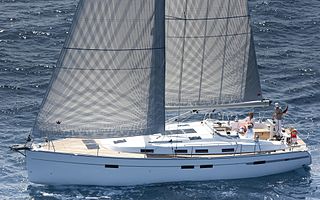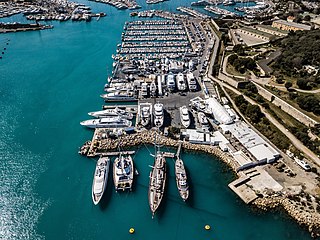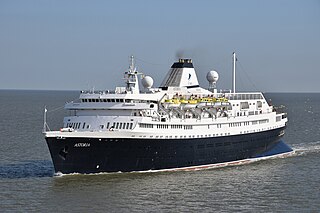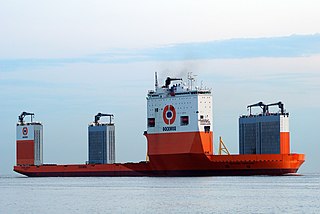
Maritime transport or more generally waterborne transport, is the transport of people (passengers) or goods (cargo) via waterways. Freight transport by sea has been widely used throughout recorded history. The advent of aviation has diminished the importance of sea travel for passengers, though it is still popular for short trips and pleasure cruises. Transport by water is cheaper than transport by air or ground, but significantly slower for longer distances. Maritime transport accounts for roughly 80% of international trade, according to UNCTAD in 2020.

A yacht is a sailing or power vessel used for pleasure, cruising, or racing. There is no standard definition, though the term generally applies to vessels with a cabin intended for overnight use. To be termed a yacht, as opposed to a boat, such a pleasure vessel is likely to be at least 33 feet (10 m) in length and may have been judged to have good aesthetic qualities.

A shipyard, also called a dockyard or boatyard, is a place where ships are built and repaired. These can be yachts, military vessels, cruise liners or other cargo or passenger ships. Compared to shipyards, which are sometimes more involved with original construction, dockyards are sometimes more linked with maintenance and basing activities. The terms are routinely used interchangeably, in part because the evolution of dockyards and shipyards has often caused them to change or merge roles.

The metacentric height (GM) is a measurement of the initial static stability of a floating body. It is calculated as the distance between the centre of gravity of a ship and its metacentre. A larger metacentric height implies greater initial stability against overturning. The metacentric height also influences the natural period of rolling of a hull, with very large metacentric heights being associated with shorter periods of roll which are uncomfortable for passengers. Hence, a sufficiently, but not excessively, high metacentric height is considered ideal for passenger ships.

A merchant ship, merchant vessel, trading vessel, or merchantman is a watercraft that transports cargo or carries passengers for hire. This is in contrast to pleasure craft, which are used for personal recreation, and naval ships, which are used for military purposes.

A platform supply vessel (PSV) is a ship specially designed to supply offshore oil and gas platforms. These ships range from 50 to 100 metres in length and accomplish a variety of tasks. The primary function for most of these vessels is logistic support and transportation of goods, tools, equipment, and personnel to and from offshore oil platforms and other offshore structures. In recent years, a new generation of platform supply vessels entered the market, usually equipped with Class 1 or Class 2 dynamic positioning system.

Capsizing or keeling over occurs when a boat or ship is rolled on its side or further by wave action, instability or wind force beyond the angle of positive static stability or it is upside down in the water. The act of recovering a vessel from a capsize is called righting. Capsize may result from broaching, knockdown, loss of stability due to cargo shifting or flooding, or in high speed boats, from turning too fast.

The MS al-Salam Boccaccio 98 was an Egyptian Ro/Ro passenger ferry, operated by El Salam Maritime Transport, that sank on 3 February 2006 in the Red Sea en route from Duba, Saudi Arabia, to Safaga in southern Egypt.

A liftboat is a self-propelled, self-elevating vessel used in support of various offshore mineral exploration and production or offshore construction activities. A liftboat has a relatively large open deck to accommodate equipment and supplies, and the capability of raising its hull clear of the water on its own legs so as to provide a stable platform from which maintenance and construction work may be conducted.

DFDS Seaways is a Danish shipping company that operates passenger and freight services across northern Europe. Following the acquisition of Norfolkline in 2010, DFDS restructured its other shipping divisions into the previously passenger-only operation of DFDS Seaways.

Wapama, also known as Tongass, was a vessel last located in Richmond, California. She was the last surviving example of some 225 wooden steam schooners that served the lumber trade and other coastal services along the Pacific Coast of the United States. She was managed by the National Park Service at San Francisco Maritime National Historical Park until dismantled in August 2013.

MV Astoria is a ship that was constructed as the transatlantic ocean liner Stockholm for Swedish American Line, and rebuilt as a cruise ship in 1993. Ordered in 1944, and commenced service in 1948, at 73 years old, she is the oldest passenger liner still sailing in deep water routes. As Stockholm, she was best known for an accidental collision with Andrea Doria in July 1956, resulting in the sinking of the latter ship and 46 fatalities off the coast of Nantucket, Massachusetts, United States.

BOKA Vanguard is a semisubmersible heavy-lift ship owned and operated by Dockwise B.V. Dockwise Vanguard is the largest vessel of her type ever built, and is able to carry cargoes up to 110,000 tonnes. Dockwise Vanguard was designed to move offshore oil and gas facilities, but can also carry other ships and act as an offshore dry-dock facility.

The Al Basra-class offshore support vessel is a 60-meter (200 ft) multi-function offshore support vessel, providing a wide range of capabilities from command and control, to support and protection of oil/Gas installations, to acting as a "mothership" for patrol boats. Vessels of the class are operated by the United States Navy and the Iraqi Navy.
SS Sardinia was a passenger-cargo ship which caught fire off Malta's Grand Harbour on 25 November 1908, resulting in at least 118 deaths. The ship was carrying Moroccan pilgrims on the way to Mecca. It is believed that a cooking fire on deck accidentally ignited nitrate in one of the ship's cargo holds, resulting in a number of explosions and causing the ship to run aground.
Vsevolod Bobrov is an Elbrus-class logistics support vessel in the Russian Navy. Built by the Severnaya Verf Shipyard from 2013 to 2021, the ship is used for transporting dry cargo, water, and ammunition, as well as providing search-and-rescue, medical support, and towing capabilities. The ship was named after the Soviet football and ice hockey player Vsevolod Bobrov.














